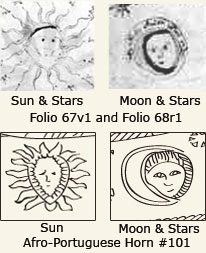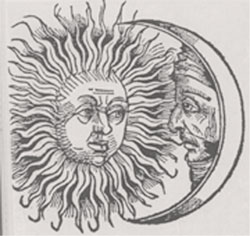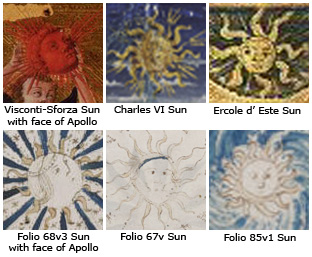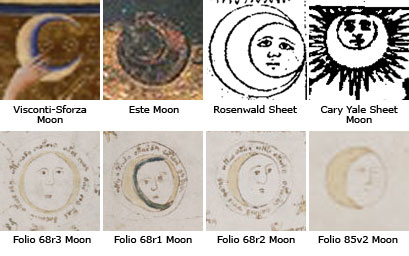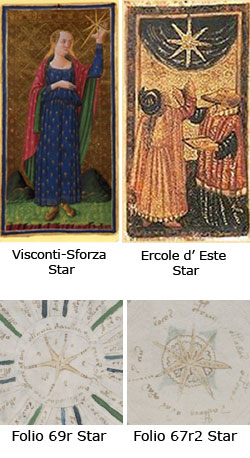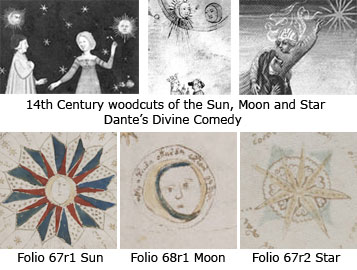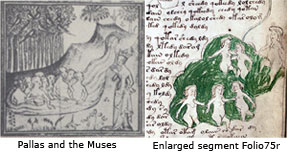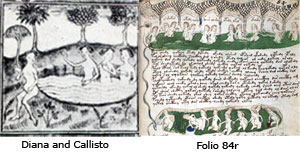Voynich Manuscript: was the author left-handed?
For the past century, the best and brightest brains in cryptography have attempted to decipher the Voynich Manuscript. So far no one has succeeded in cracking the code. Under these circumstances, one approach is to look at the document and let it speak for its self, ignoring earlier ideas relating to its origin. I therefore took a careful look at all the drawings, while trying to avoid becoming confused by some of their bizarre characteristics. The first thing that I noticed was that the cosmological drawings of the sun, moon and stars in folios 67v1 and 68r2 (Figure 1, top row) were very similar to carvings of the sun and the moon and stars on a very fine Afro-Portuguese ivory horn(1) No.101 (Figure 1, bottom row)(I) The horn was decorated with other European motifs, including the arms of the House of Aviz. This indicated that the horn was intended for King Emanuel I of Portugal and was carved some time during his reign(1495-1521)(2), i.e. around the beginning of the 16th century.
Sun and moon symbols are not African in origin. Bassani and Fagg suggested that they may have been copied from a drawing in Liber Chronicarum, first published in 1493 (Figure 2). On a recent trip to Italy, I found that these icons are popular in Southern Italy, however all the moons had crescent shaped faces resembling the moon shown in Figure 2 and not round faced like the moon on the horn or on the folio 68r1 drawing. The use of these symbols in Italy date back over two thousand years to Greek and Roman mythology. The sun represented Apollo and the moon Diana.
I used the Internet to check for 16th century sources using sun, moon and star motifs. The surprising result was Tarot cards. Three cards in Tarot’s major arcana represent the Sun, Moon and a Star. Arabs from North Africa introduced playing cards into Spain and Italy around 1379. These cards were the standard deck of 52 cards the same as decks in use today(3). A Tarot deck also has four suites, each with thirteen cards, but with an additional face card per suit and a fool (joker) (minor arcana) and 21 trump cards (major arcana), i.e. 78 cards in all(II). The game originated in Northern Italy and the oldest surviving incomplete deck was painted, c~1450 for the Visconti- Sforza family of Milan. After the French invaded Milan in 1499, the game probably spread into France and Switzerland. There is no evidence that the English ever played with Tarot cards, but they did enjoy playing and gambling with regular playing cards. It was during the 18th century that playing the Tarot card game died out and the cards were used for fortune telling.
Figure 3 compares three examples of the sun from 15th century Tarot cards(III) with drawings of Voynich Manuscript suns found on folios 68v3, 67v and 85v1. A sun card from the Visconti-Sforza set (c~1450), shows the face of the Roman Sun God, Apollo. The sun in the Voynich Manuscript folio 68 v1, also has Apollo’s face. This is unusual and suggests that the author of the Voynich Manuscript may have copied this image of the sun from the Visconti-Sforza set or a similar set of tarot cards.
Figure 4 gives a comparison of two 15th century moon tarot cards and moons from two surviving early 16th century uncut woodblock sheets of Tarot cards, with examples of moons drawn on folios 68r3, 68r1, 68r2 and 87r2. The similarity between the Tarot moons and the Voynich Manuscript moons are not as close as the sun icons. The drawings of the small stars on folios 68r3, 68r1 and 68r2 are very like the carvings of the little stars on the Afro-Portuguese ivory horn No.101.
Figure 5 shows examples of 15th century tarot star cards and star icons from Voynich Manuscript folios 69r and 67r2. Again the likeness between the Tarot cards and the drawings of Voynich Manuscript stars are close. Another folio, folio 57v, resembles the wheel of fortune card from the Visconti-Sforza Tarot deck (Figure 6). Both drawings represent the four stages of man: childhood, youth, adult and old age, showing the inevitability of life and death. The wheel was a medieval instrument of torture so this drawing could have a double meaning indicating that man has little control over the fickleness of fate.
While researching the origin of Tarot cards, I was fortunate to find Dr. Robert O’Neill’s web site, Iconology of Tarot cards(IV). He suggests that the images of the sun, moon and star used on 15th century Tarot cards, were probably copied from 14th century woodcuts used to illustrate Dante’s Divine Comedy. Dante wrote the book between the years 1308-1321. It has many illustrations that may be the source of the symbols used for the sun, moon and star Tarot cards. In fact as Figure 7 shows, drawings of the moon used in Dante’s Divine Comedy are even closer to the images used for the Voynich Manuscript and Afro-Portuguese horn No.101 than those used on early moon Tarot cards.
The purpose of the drawings of suns, moons and stars in the Voynich Manuscript is unclear. They do not appear to have any cosmological significance, nor do they appear to have been intended as cards for a potential pack of Tarot cards. The drawing of a sun with Apollo’s face, in folio 68 v1, could indicate an association with Roman mythology. The sun, moon and star (representing the planet Venus) could also be related to alchemy, where these symbols represent gold, silver and copper respectively. These icons are also symbols used by secret societies like the Free Masons.
There were many Italians involved in the 15th and early 16th centuries with Portuguese voyages to West Africa, India, Brazil and the Orient, well known people like Christopher Columbus(4), Bartolomeo Marchionni(5), Amerigo Vespucci(6), Giovanni of Empoli(7), and Andrea Corsali(8). As early as 1436 the Este court in Ferrara, Northern Italy, was using a small press to print sheets of playing cards. Figure 4 shows an example of a block of a few 15th century printed Tarot cards. Although only examples of expensive cards have survived, card playing was popular and cheap decks sold for reasonable prices. Early explorers may have entertained themselves during long voyages playing various card games. In fact the African carvers from Guinea may have seen these cards, copied some of their drawings and fashioned their ivory saltcellars after the cups/chalices (clubs) that were used as pips on the early Italian playing and Tarot cards. This would account for the sun, moon and star motifs on the Afro-Portuguese horn No.101.
It was exciting to discover the probable source of the little nude bathing beauties who are cavorting in pools of green slime on some of the Voynich Manuscript folios (the biological section of the manuscript) As they say, one thing leads to another. An Afro-Portuguese ivory horn led to Tarot cards and Tom Tadfor Little’s Tarot history site, to Dr. Robert O’Neill’s Tarot site, showing that Dante’s Divine Comedy, and from there to Jean Seznec’s The Survival of the Pagan God(V) and an illustration from a 14th century manuscript, Ovide Moralise(9), showing Pallas watching the nude Muses bathing in a pond. Figure 8 shows a comparison of Folio 75r from the Voynich Manuscript with this 14th century woodblock. Figure 9 compares a second drawing from Ovide Moralise that depicts a pregnant Callisto being chased from a pond by Diana and her nymphs with folio 84r. Ovide Moralise may have inspired these drawings in the Voynich Manuscript. Jim Reed noted that in the 1972 Princeton edition of The Survival of the Pagan God, a picture labeled ‘Venus Luxuria’(VI) reminded him of the Voynich Manuscript’s balneological drawings(VII). This picture was taken from a manuscript of the ‘Fulgentius Metaforalias’, Vatican, Palat, lat 1726, and shows the goddess Venus swimming in a pool with some fish. This is additional evidence that these drawings may be related to Roman/Greek mythology.
One problem I have always had in assigning authorship of the Voynich Manuscript to Roger Bacon, are these ‘biological/ balneological’ drawings. I cannot believe that a very learned Franciscan priest, scholar and scientist like Roger Bacon would have made drawings of this type. He. possessed one of the most commanding intellects of his age and is regarded as the founder of modern science. These drawings have a childlike quality, and are probably the product of a gifted child copying pictures from a book he was reading.
A French Benedictine monk, Pierre Bercheure (1290-1362), in 1340, wrote Ovide Moralise, an epic poem that is an expurgated version of Ovid’s Metamorphosis. This poem was widely read and is considered to have influenced Chaucer’s writing of Canterbury Tales. Bersuire met Petrarch, the Florentine poet and philosopher (1304-1374) in Avignon around 1320 and again in Paris in 1340. Tarot cards were originally called ‘carta da trionfi’ and the Visconte-Sforza Tarot pack may have been based on Petrarch’s classic poem I Trionfi(VIII). Petrarch may have encouraged the reading of Ovide Moralise in Italy. An English Franciscan monk, John Ridewall, in the first half of the14th century, wrote Fulgentius Metaforalias, another moralization of mythology.
The above observations lead to the following conclusions concerning the authorship of the Voynich Manuscript:
- Roger Bacon died in 1294. He probably never saw a pack of playing cards and the Tarot card game was invented c~150 years after his death. The Benedictine monk, Pierre Bersuire wrote Ovide Moralise in 1340. The manuscript with the woodcut of Pallas and the muses would have been from an even later date. Roger Bacon could not have read the treatise, ‘Fulgentius Metaforalias’, written fifty years after his death, by his fellow country man John Ridewall. Roger Bacon is therefore an unlikely author of the Voynich Manuscript unless he like Lazarus rose from the dead.
- Could John Dee (1527-1608) and or his questionable scrier, Edward Kelley, have forged the Voynich Manuscript? This I consider unlikely. John Dee, in spite of his involvement in scrying, was a learned man with an extensive library including manuscripts written by Roger Bacon. If he had forged the Voynich Manuscript, he would have ensured authenticity by using material copied from Roger Bacon’s own writings. As Rob Churchill has pointed out, the Voynich Manuscript bears little similarity to any of Roger Bacon’s works(IX). John Dee was too intelligent to forge a ‘Roger Bacon’ manuscript that included copies of drawings from very well known 14th century books or a 15th century card game.
- This argument also applies to Edward Kelley, who as a close associate of John Dee, would have had access to Roger Bacon’s books. Leonardo da Vinci owned a printed copy of one of Roger Bacon’s books(X), showing that his writings were well known in Europe.
- Some people have considered the possibility that Wilfred Voynich forged the Voynich Manuscript. Wilfred Voynich’s business was in buying and selling old manuscripts and again it is unlikely that he would have copied from French and Italian manuscripts written after Roger Bacon’s death or seen early Tarot cards like the Visconti-Sforza pack.
- If the Voynich Manuscript was not written by Roger Bacon and not forged by John Dee, Edward Kelley or Wilfred Voynich, then who? The manuscript has never been dated. Jim Reed suggests that the vellum used for the manuscript was manufactured between 1450-1460(XI). The limited selection of clothes and hats, in the Voynich Manuscript, are compatible with the dress of common people between the dates 1450 and 1550(XII). Brumbaugh claims that the archer in the Sagittarian astrological chart is wearing a Florentine hat(XIII). The association of some Voynich Manuscript folios depicting Diana and Callisto and Pallas and the Muses, suggests a link to 15th century Florence. The intellectual and artistic elite of the city were obsessed with Neoplatonism, antiquity and Roman and Greek mythology(XIV).
- Although the Voynich Manuscript, with the exception of the last page, has no recognizable alphabet, the script does show the influence of the ‘humanistic hand’, a style of writing that appeared in Florence just before 1400(XV). Statistical analysis using Zipf’s Law indicates that the Voynich text is not a random sequence of letters and is probably not a forgery using a purely random series of symbols. The entropy measurement indicates a low level language(XVI). The author probably had the limited vocabulary of an individual with no formal education.
- The drawings were done before the text. The smooth left margin(XVII) indicates that it was written from left to right. A quill pen was used and as expected, the ink pattern shows dark to light patterning as the writing moved from left to right. However in a few cases this pattern was reversed, indicating retouching or partial right to left writing(XVIII). The Voynich Manuscript has very few corrections, and the writing demonstrates speed and fluency. The cosmological drawings indicate that the author was a skilled draftsman.
- If Wilfred Voynich considered Roger Bacon a suitable 13th century author of the Voynich Manuscript, because he may have wished to hide scientific, astrological or cosmological knowledge from the prying eyes of the church, then Leonardo da Vinci would be an equally suitable candidate from 15th century Florence/Italy. In spite of limited schooling, he would have read Dante’s Divine Comedia (a must for all school boys of his time), he would have seen the Visconti-Sforza cards when he worked at the Sforza court in Milan from c~1481-1500. He owned a copy of Ovid’s Metamorphosis and Petrach’s books(XIX). Whether he knew or read Ovide Moralise is not known. He was by nature secretive, and enjoyed pranks and riddles. As Serge Bramly(XX) rightly observed, Leonardo had the whiff of sulfur about him and probably had much to hide from the Vatican and the prying eyes of the Inquisition.
-
On my earlier web site, ‘Leonardo de Vinci and the Voynich Manuscript’ I suggested that a
young Leonardo da Vinci was the author of this manuscript. I still consider him to be a likely candidate. Leonardo was left-handed, so if it can be shown that the author of the Voynich Manuscript was right-handed this would exclude him as an author. Right-handed people naturally write/draw from left to right. Hatching strokes used in drawings by right-handed people start at the top of the stroke and move down as the pen moves from left to right with each additional stroke. Left-handed Leonardo generally began hatching from the lower right, coursing upward while moving from right to left i.e. the reverse of right-handed hatching. The starting point of a hatching stroke can be determined by the point on the line with the greatest accumulation of ink(XXI). I therefore checked all the drawings in the Voynich Manuscript for examples of hatching and found one in Folio 84r. As Figure 10 shows, the author of the Voynich Manuscript was left-handed. The famous ‘Sunflower’, folio 33v, also shows left-handed hatching. Figure 11 compares an authentic example of Leonardo’s hatching(XXII) with a section of Folio 84r, using only the blue channel of Adobe Photoshop for both drawings. Both of these examples show a slight right hook on the lower end of some of the hatching lines, confirming that the author of the Voynich Manuscript was left-handed. Jim Finn(XXIII) has observed that the spiral image in folio 68v3 may be a mirror image representation of our galaxy, the Milky Way.
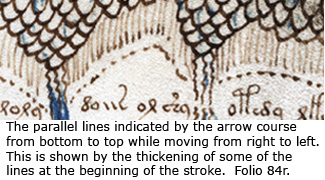 Figure 10
Full Image
Figure 10
Full Image
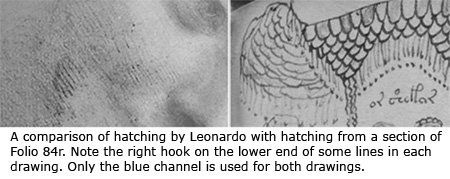 Figure 11
Full Image
Figure 11
Full Image
- While the left-handed hatching and a mirror image drawing does not prove that Leonardo is the author of the Voynich Manuscript, this is valuable supportive evidence. The 15th century belonged to a time in history when left-handedness was considered the devil's work and lefties were forced to use their right hand. For example, Michelangelo, another lefty, trained himself to draw with his right hand. Leonardo wrote almost exclusively in mirror image script from right to left, but on occasion, when it was necessary for drawings like maps to be labeled, he wrote in normal script(XXIV). He was probably ambidextrous and during his youth made to write, like other left-handed children, with his right hand.
-
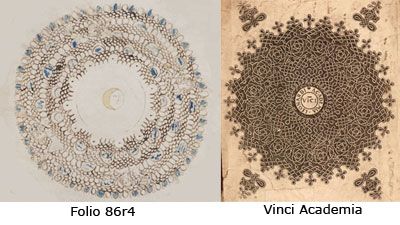 Figure 12
Full Image
The Voynich Manuscript was probably Leonardo’s first manuscript, and in spite of the childlike quality of some of the drawings, inspired from books he read during his limited schooling, the penmanship and the drafting of the astrological and cosmological drawings are the work of a potential genius. It is not surprising to find that Leonardo invented a cipher that no one has been able to decode or that he produced a manuscript that has fascinated and confounded several generations of scholars, intellectuals and cryptologists(XXV) Folio 86r4 is a drawing that could almost be regarded as his signature. Compare this drawing with the drawing ‘Vinci Acadamie’ (Figure 12). There is a distinct similarity in style between the two drawings.
Figure 12
Full Image
The Voynich Manuscript was probably Leonardo’s first manuscript, and in spite of the childlike quality of some of the drawings, inspired from books he read during his limited schooling, the penmanship and the drafting of the astrological and cosmological drawings are the work of a potential genius. It is not surprising to find that Leonardo invented a cipher that no one has been able to decode or that he produced a manuscript that has fascinated and confounded several generations of scholars, intellectuals and cryptologists(XXV) Folio 86r4 is a drawing that could almost be regarded as his signature. Compare this drawing with the drawing ‘Vinci Acadamie’ (Figure 12). There is a distinct similarity in style between the two drawings.
- ↑ back Afro-Portuguese Ivories - The first trade goods from West Africa sold in Europe at the beginning of the 16th century, were the Afro-Portuguese Ivories, exquisitely carved spoons forks, saltcellars, pyxes and horns that are found today in museums in Europe and America.
- ↑ back 15th century Portugal - In the 15th century the Portuguese were seeking a trade route around Africa to India and the Spice Islands. This resulted in the exploration of the West Coast of Africa where gold was located at El Mina. They traded for gold, slaves and ivory with the local African people.
- ↑ back Tarot cards - Early Italian decks used suites represented by staves, cups, swords and coins. Early English decks used the traditional clubs, diamonds hearts and spades.
- ↑ back Christopher Columbus - sailed with the Portuguese to West Africa and lived in Madeira before he discovered America.
- ↑ back Bartolomeo Marchionni - a Florentine banker who lived in Lisbon and helped bank role the Portuguese voyages of exploration. He was also involved with trade in West Africa, particularly Guinea and Benin where these Afro-Portuguese ivories were made.
- ↑ back Amerigo Vespucci - a Florentine business man, who sailed with Christopher Columbus, explored the coast of South America and proposed that a new continent had been discovered.
- ↑ back Giovanni of Empoli - a Florentine employee of Bartolomeo Marchionni who sailed on a number of Portuguese voyages to India and beyond.
- ↑ back Andrea Corsali - an Italian trader, who was the first person to describe the Southern Cross.
- ↑ back Ovide Moralise - Cod 742 of the Bibliotheque de Lyon.
- ↑ back Bassini, E. and Fagg, W., 1988, Africa and the Renaissance Art in Ivory, Prestel-Verlag, Munich, p.120, 92, 93 and 106.
- ↑ back Little,T. T., 1999, The Hermitage: Tarot History. http://www.tarothermit.com
- ↑ back Pictures of early tarot cards were obtained from: http://www.frooldbooks.org/ViscontiSforzaTarotCards http://www.beinicke.library.yale.edu/dl_crosscolex/searchExecXC.asp?srchtype=&curpage=5 http://www.tarotpedia.com.wiki/carysheet
- ↑ back O’Neill, R., Aeclectic Tarot, http://www.aeclectic.net/tarot/learn/robert_oneill.shtml
- ↑ back Seznec, J.,2004, The Survival of the Pagan Gods, Harper Torchbooks, New York, p.110.
- ↑ back Reed, J., 1995, in Historical Precedents for the Voynich Manuscript, http://www.geocities.com/ctesibos/voynich/precednt.html, p7.
- ↑ back Seznec, J.,2004, The Survival of the Pagan Gods, Harper Torchbooks, New York, p.107.
- ↑ back Molakley, G., The Tarot cards, www.geocities.com/cartedetrionfi/misc/moakley.html
- ↑ back Kennedy G. and Churchill R., 2004, The Voynich Manuscript, Inner Traditions, Vermont, p.261.
- ↑ back MacCurdy, E., The Notebooks of Leonardo da Vinci, Definitive Edition in One Volume, The New York Time, p.1171.
- ↑ back Reed, J., ibid p11.
- ↑ back D’Imperio M.E. 1978, The Voynich Manuscript: An Elegant Enigma, Aegean Park Press, p.64.
- ↑ back Kennedy G. and Churchill R., ibid, p.184.
- ↑ back Seznec, J. ibid, p. 99-119.
- ↑ back D’Imperio M.E. ibid, p.15.
- ↑ back Kennedy G. and Churchill R., ibid, p.259-260.
- ↑ back Wikipedia, Voynich Manuscript, http://en.wikipedia.org/wiki/Voynich_manuscript
- ↑ back Antonini, C.,2000, Visit to Beneicke, http://www.voynich.net/Arch/2000/11/msg/00015.html.p4.
- ↑ back MacCurdy, E., The Notebooks of Leonardo da Vinci, The New York Times, p.1163-1173.
- ↑ back Bramly, S., 1994, Leonardo the Artist and the Man, Pengiun Books.
- ↑ back Bambach, C., 2003, Leonardo, Left handed Draftsman and Writer, in Leonardo da Vinci Master Draftsman, Ed Bambach, Yale University Press, p.31-59.
- ↑ back Bambach, C., in www.metmuseum.org/special/Leonardo_Master_Draftsman/draftsman_left_essay.asp
- ↑ back Kennedy, G and Churchill, R. ibid, p.252.
- ↑ back Richter, J.,P.,1970, The Notebooks of Leonardo da Vinci Vol.II, Dover Publications, New York, PL. CXII
- ↑ back Kennedy, G and Churchill, R. ibid, p.1.
